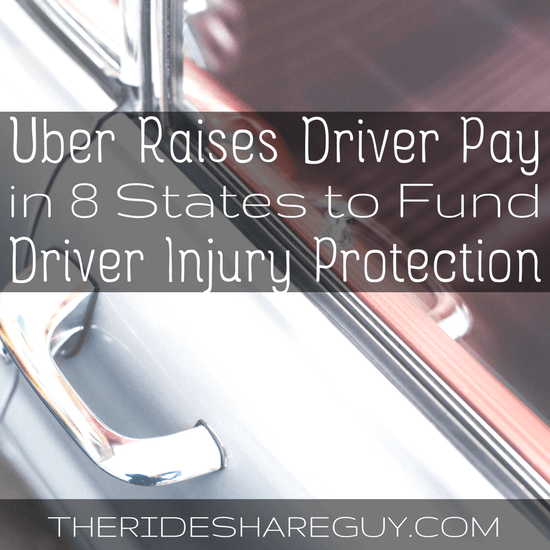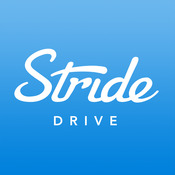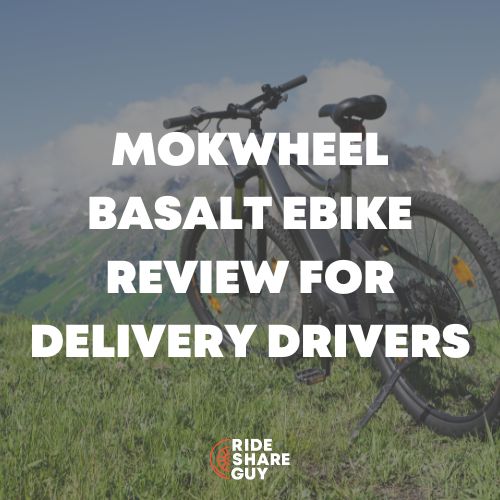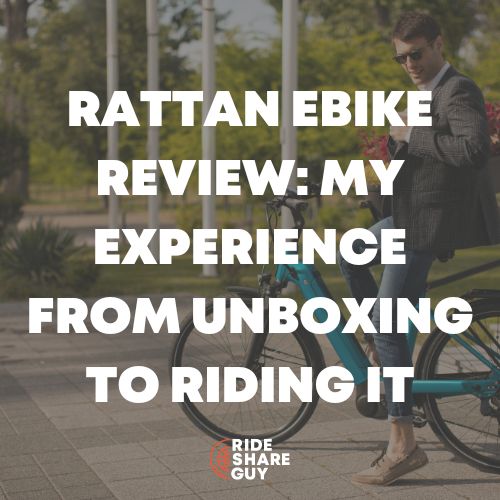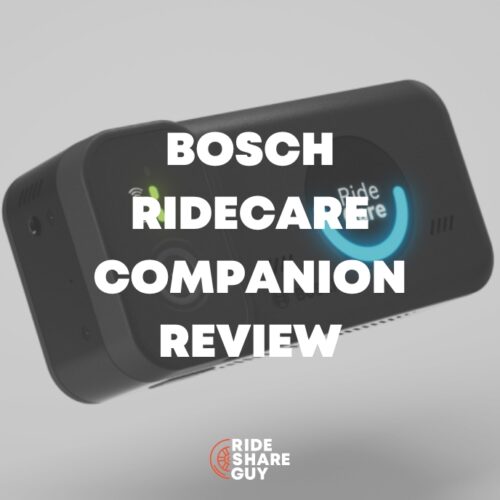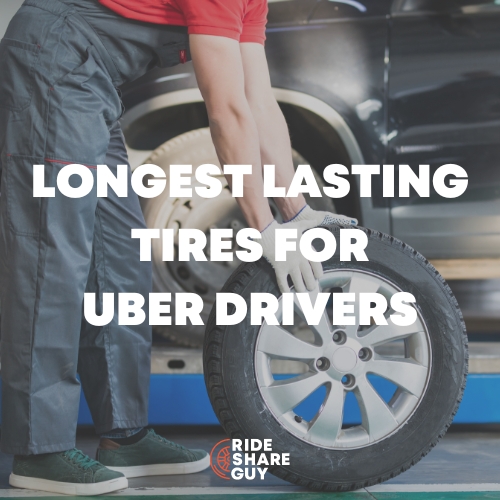Recently, Uber decided to roll their Driver Injury Protection program out to even more states, meaning more drivers may be seeing a total increase to their earnings. In this update, senior RSG contributor Christian Perea outlines what this pay increase is for and its potential impact on drivers in the future.
Recently Uber announced a 5 cent per mile pay increase in order to fund Driver Injury Protection insurance. Uber announced they are doing this in partnership with OneBeacon and Aon as a program that could eventually expand nationwide. Drivers in these states will be able to sign up for injury protection and pay into a fund OR simply collect an extra $0.05/mile. That’s obviously not a huge pay increase, but every little bit counts.
The program is unique because it shows how Uber may pilot other driver pseudo-benefit programs in the future. On-demand work has often been criticized because there are no traditional workplace protections for those who get injured on the job. This seems to be a good way to offer full-time drivers something valuable while allowing part-timers to opt-out.
The higher mileage rate is actually meant to offset the cost of the insurance though, so if you opt in you’ll have to pay $.0375 cents/mile for every mile you have an Uber passenger in your car (on trip miles). However, the Driver Injury Protection is active the entire time that you’re logged into the Uber app, even when you’re are waiting for a request. If you don’t not sign up, you will still enjoy the increase $0.05 increase in per mileage earnings. but no coverage.
The rate increase of $0.05/mile and option for Driver Injury Protection will be effective in the following states (recent additions are in bold):
- Alabama
- Arizona
- Arkansas
- California
- Delaware
- District of Columbia
- Florida
- Georgia
- Illinois
- Indiana
- Iowa
- Kansas
- Louisiana
- Maryland
- Massachusetts
- Michigan
- Missouri
- Nebraska
- Nevada
- New Jersey
- North Carolina
- North Dakota
- Ohio
- Oklahoma
- Oregon
- Pennsylvania
- South Carolina
- Texas
- Virginia
- West Virginia
- Wisconsin
- Wyoming
Uber is planning on rolling this program out to more states, but as it rolls out, it is approved on a state-by-state basis. If it’s not in your state yet, you may see it in the coming months.
What Is Uber Driver Injury Protection Insurance?
If an Uber driver is injured or hurt on the job, they will have their medical expenses covered with an earnings reimbursement of up to $500/week depending on their previous driver pay history. According to an Uber spokesman, this will include up to $1,000,000 in protection.
This type of insurance can be valuable for a full-time driver who spends between 40 and 60 hours a week on the road because driving is inherently a dangerous job. The more time one spends on the road, the more likely they are to get into an accident or experience a situation where their back gives out while lugging Larry’s luggage at the airport.
How is It Different From Uber’s Standard Insurance?
Uber’s standard auto insurance through James River covers liability in the event that the driver is at fault for an accident. When you have a passenger in the car, you have contingent full coverage, which means that damage to your vehicle is covered by James River (Uber’s insurance company) but getting recovery for lost wages and medical expenses can be difficult.
Most drivers don’t know this but if you get into an accident and the other person is at fault, you can actually go after the other party for lost wages, medical expenses and more. It’s a complicated process but we recommend working with an Uber Accident Lawyer to ensure you get the best settlement.
Driver Injury Protection though, is meant to act as a replacement for workers’ comp insurance and provide a layer of protection to the worker (the Uber driver) regardless of whether there was an accident.
Is Driver Injury Protection Insurance Right For You?
I think something like this can be really valuable for full-time drivers (assuming the protection is good). If you rely on this as a source of income, then it’s probably worth the $0.0375/mile to make sure that you will be all right if you get injured while driving. It makes sense that the more time you spend on the road, the more likely you are to get injured via a car accident. If you drive 50 hours a week, it’s almost inevitable regardless of how safe you drive. Most full-time drivers I know have been in at least one accident.
However, I think most part-time drivers will choose to not signup for it (even if they should). Many of them drive as a second or third source of income to supplement their primary job, which often provides healthcare and other benefits. Many drivers will also be more tempted to cash-in on the short-term gains from the extra five cents a mile.
What Other Benefits/Partnerships Has Uber Done For Drivers?
Uber already has a bevy of partnerships in place to help drivers figure out things like their healthcare, retirement, accounting and taxes. As of right now, most partnerships are pretty simple in that Uber (or Lyft) kind of just lets drivers know that they have options and tools to save money. However, if you look closely you can see how they may resemble a benefits package.
Stride Drive / Stride Health
Stride is a pretty cool company. Their most popular app is called Stride Drive. It allows you to track your mileage when you drive for Uber (or other rideshare apps). It’s available on Android and iOS, tracks expenses, mileage, and helps you get things figured out for taxes. It’s also free to use. Check it out if you haven’t yet here.
Stride Health is a marketplace for health insurance plans for on-demand workers. I used Stride Health to find the best plan for me earlier this year and it has ended up proving to be a great decision for me since I hadn’t seen a doctor for a while, and it turned out that I actually had some pretty serious medical stuff to squash. Stride Health simplified the complex world of health insurance and helped me upload all of the documents necessary to setup my plan.
The Uber Fuel Card
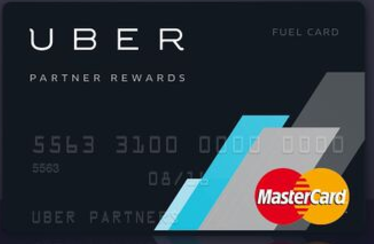 Uber has had a partner fuel card for a while now, and it’s helped drivers make sure they can fill up their tank throughout the week with some small discounts in the process. Drivers actually may qualify for other business credit cards that offer better rewards programs.
Uber has had a partner fuel card for a while now, and it’s helped drivers make sure they can fill up their tank throughout the week with some small discounts in the process. Drivers actually may qualify for other business credit cards that offer better rewards programs.
Related: Applying for Your First Rideshare Business Credit Card
Since you are already going to be spending money on driving, I think it’s worth checking out which card offers the best rewards for you on our Credit Cards page.
I’ve been putting my purchases on a US Bank Cash+ card for the last few years, and I usually earn about $100 bucks per quarter in rewards. There are other cards out there that give rewards, and there is actually a small sub-culture of points freaks who like to hack this kind of stuff. So it’s worth doing your research.
Betterment For Retirement/Investments: A Bit of A Failure
Uber launched a partnership last year allowing drivers to set aside some of their earnings into a retirement/investment plan with Betterment. Unfortunately, I don’t think it took off because many drivers who do this for a living are probably living paycheck to paycheck and just trying to make ends meet. When rates are $0.65/mile, you’re gonna have trouble paying for a lot of things.
And if you have the resources to invest or save for retirement, I imagine you are going to shop around for the best way to invest it.
Betterment is a good idea in theory, but without a separate contribution or pay increase to drivers it just isn’t going to get much participation. You can’t retire in the future if you don’t make it there, right?
A Step Towards Portable Benefits?
Portable Benefits is the idea that a driver can work for multiple companies like Uber, Lyft and DoorDash and pay into the same “benefits” policy/package. Some even propose having each company contribute partially to that policy on a per-ride basis. It may seem a little whacky to imagine right now but remember, a lot of people are driving nowadays and many of those people are using driving as their primary source of income.
Companies cannot directly contribute to a benefits plan for drivers, because it would almost certainly end up being used against them in court to demonstrate that drivers are employees. What Uber has done here is significant because they have raised the prices a little bit in each market and then given drivers the choice to accept these benefits. This contribution from Uber is passed on to the passengers.
This is the first time that an on-demand company has offered something that looks like a traditional benefit AND offered a way to cover the cost for the driver.
So…would you take the nickel per mile or the driver protection insurance? Vote with your comments below!
-Christian @ RSG
